GROUP FORMS TO CLEAN UP THE UPPER SAN JACINTO BEFORE IT GETS AS BAD AS BRAYS, BUFFALO, SIMS BAYOUS 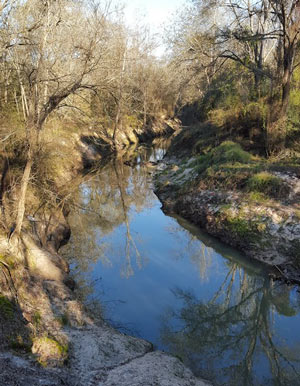 The West Fork of the San Jacinto River (implicated in much of the latest flooding between The Woodlands and Conroe) is in a bacterial “sweet spot”, environmental planner Justin Bower tells Matthew Tresaugue in the Houston Chronicle this week  — more contaminated than is acceptable, Bower says, “but not so much that we can’t do anything about it.” Tresaugue writes that E. coli levels have been trending upward since 2002, in some cases running as high as 10,000 colonies per 100 milliters of water (around 80 times higher than the 126-colony limit recommended by the state of Texas). The river’s water quality problems are multifaceted, but generally boil down to increased development in the watershed causing increased runoff that carries more junk — from human and animals waste to sediment from a nearby gravel mining operation — into the river and ultimately the Lake Houston reservoir (from which the city pulls drinking water). The newly formed West Fork Watershed Partnership has no definite plan yet (other than to work with area stakeholders to develop a plan). But Lisa Gonzalez (VP of the Houston Area Research Council) notes to Tresaugue that not doing anything could allow the West Fork’s water problems to get as bad as those of other major urban waterways in Houston. [Houston Chronicle; previously on Swamplot] Photo of West Fork of the San Jacinto: West Fork Watershed Partnership
The West Fork of the San Jacinto River (implicated in much of the latest flooding between The Woodlands and Conroe) is in a bacterial “sweet spot”, environmental planner Justin Bower tells Matthew Tresaugue in the Houston Chronicle this week  — more contaminated than is acceptable, Bower says, “but not so much that we can’t do anything about it.” Tresaugue writes that E. coli levels have been trending upward since 2002, in some cases running as high as 10,000 colonies per 100 milliters of water (around 80 times higher than the 126-colony limit recommended by the state of Texas). The river’s water quality problems are multifaceted, but generally boil down to increased development in the watershed causing increased runoff that carries more junk — from human and animals waste to sediment from a nearby gravel mining operation — into the river and ultimately the Lake Houston reservoir (from which the city pulls drinking water). The newly formed West Fork Watershed Partnership has no definite plan yet (other than to work with area stakeholders to develop a plan). But Lisa Gonzalez (VP of the Houston Area Research Council) notes to Tresaugue that not doing anything could allow the West Fork’s water problems to get as bad as those of other major urban waterways in Houston. [Houston Chronicle; previously on Swamplot] Photo of West Fork of the San Jacinto: West Fork Watershed Partnership
Tag: Lake Houston
YES, YOU’VE BEEN SIPPING WHAT DALLAS HAS BEEN FLUSHING 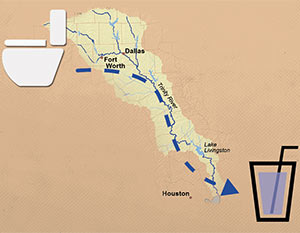 “For the large chunk of population that lives downstream from a big city and whose water supply flows through a river, more than a few drops of the water in their glasses was probably once in someone else’s toilet,” Neena Satija drily notes in her reassuring survey for the Texas Tribune of sewage-treatment projects throughout the state. Her story is worth checking out for the animated image diagramming the flow from a Fort Worth-area toilet to a Houston highball glass alone (excerpted screenshot shown at left, above), but she does stir up some oft-repeated local poop: “Let’s start with Houston, which, as Texas State University professor Andy Sansom says, ‘has been drinking Dallas’ crap for decades,’” she writes. “Wastewater from Dallas and Fort Worth is deposited into the Trinity River, where it flows down into the lakes that supply Houston residents. The wastewater is so clean that it’s credited with helping the Trinity River stay strong during recent years of severe drought.” [Texas Tribune; previously on Swamplot] Illustration: Todd Wiseman/Alessandro Suraci/Luis Prado
“For the large chunk of population that lives downstream from a big city and whose water supply flows through a river, more than a few drops of the water in their glasses was probably once in someone else’s toilet,” Neena Satija drily notes in her reassuring survey for the Texas Tribune of sewage-treatment projects throughout the state. Her story is worth checking out for the animated image diagramming the flow from a Fort Worth-area toilet to a Houston highball glass alone (excerpted screenshot shown at left, above), but she does stir up some oft-repeated local poop: “Let’s start with Houston, which, as Texas State University professor Andy Sansom says, ‘has been drinking Dallas’ crap for decades,’” she writes. “Wastewater from Dallas and Fort Worth is deposited into the Trinity River, where it flows down into the lakes that supply Houston residents. The wastewater is so clean that it’s credited with helping the Trinity River stay strong during recent years of severe drought.” [Texas Tribune; previously on Swamplot] Illustration: Todd Wiseman/Alessandro Suraci/Luis Prado
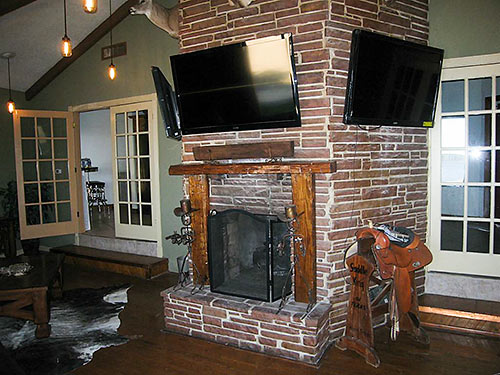
- 18603 Bluffview Dr. [HAR]

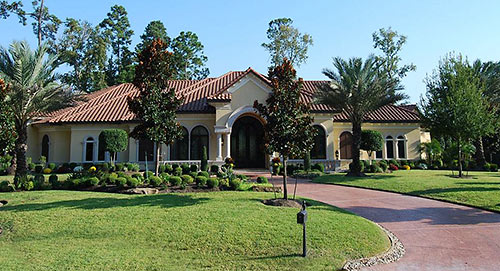
Now on its third relisting by the initial agent since 2011, a 2006 Mediterranean-style spread in Lakes at Kings River Estates is sticking to the asking price the property’s been offered at since last April. But the current price ceiling is still a few ticks down from what it was during a year-long sale attempt in 2011, which began at $2.8 million before knocking off $550K. The red-roofed Kingwood-area property, currently seeking $1.99 million, appears notable for its collection of over-the-top ceiling treatments.

- 13407 Explorer Dr. [HAR]
WHERE THE POOP IS, IN AND AROUND LAKE HOUSTON 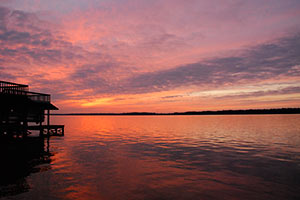 “While some Houston bayous, such as Buffalo and White Oak, have bacteria levels seven times higher than Lake Houston’s watershed, the waters flowing from the San Jacinto River are more vital, said Steve Hupp, Bayou Preservation Association spokesman. . . . Houston’s drinking water is pumped from an area of the lake not contaminated with bacteria.
Only the northwest corner of the lake is impaired, records show. This segment runs from where the river intersects Spring Creek, winds through Humble and past the Kingwood golf course, and ends at the West Lake Houston Parkway bridge.
The bacteria level found in the lake segment exceeds the state standard of 126 E. coli per 100 milliliters of water by 100 percent. Levels on both the river’s west or east forks are lower — exceeding the standard by 25 percent to 56 percent, depending on the segment. Yet a small tributary, Crystal Creek, which feeds into the west fork, has the highest count. It exceeds the state standard by 168 percent.
The communities along the San Jacinto watershed are experiencing a boom in development, especially around the river’s west fork in Montgomery County. Exxon Mobil already has a new 385-acre corporate campus that will be home to 10,000 workers under construction there, while the Boy Scouts recently sold their nearby 2,175-acre camp to a master-planned community developer for a reported $60 million.” [Houston Chronicle ($)] Photo of Lake Houston: Sara Robertson (license)
“While some Houston bayous, such as Buffalo and White Oak, have bacteria levels seven times higher than Lake Houston’s watershed, the waters flowing from the San Jacinto River are more vital, said Steve Hupp, Bayou Preservation Association spokesman. . . . Houston’s drinking water is pumped from an area of the lake not contaminated with bacteria.
Only the northwest corner of the lake is impaired, records show. This segment runs from where the river intersects Spring Creek, winds through Humble and past the Kingwood golf course, and ends at the West Lake Houston Parkway bridge.
The bacteria level found in the lake segment exceeds the state standard of 126 E. coli per 100 milliliters of water by 100 percent. Levels on both the river’s west or east forks are lower — exceeding the standard by 25 percent to 56 percent, depending on the segment. Yet a small tributary, Crystal Creek, which feeds into the west fork, has the highest count. It exceeds the state standard by 168 percent.
The communities along the San Jacinto watershed are experiencing a boom in development, especially around the river’s west fork in Montgomery County. Exxon Mobil already has a new 385-acre corporate campus that will be home to 10,000 workers under construction there, while the Boy Scouts recently sold their nearby 2,175-acre camp to a master-planned community developer for a reported $60 million.” [Houston Chronicle ($)] Photo of Lake Houston: Sara Robertson (license)

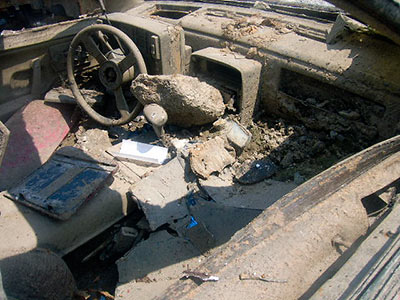
That stolen 1985 Fiero GT that HPD officers pulled from the bottom of Lake Houston last summer after a 22-year soak is now available for sale online, a reader notes. Damaged-car auction site Copart (pronounced “CO-part,” not “COP-art”) features the mangled, muddy mess in an extensive photo gallery, and pegs the car’s actual cash value (before the minor flooding incident, of course) at $2,000 — same as the estimated cost to repair. Minimum bid for the fiberglass-paneled former vehicle: $175. Houston’s Art Car Parade is less than 3 months away.
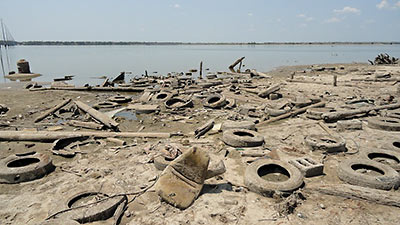
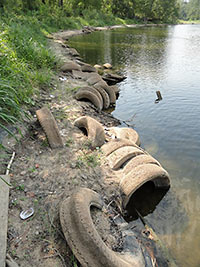 Low water levels have exposed more Lake Houston automotive bounty than just that mid-eighties Pontiac Fiero that was liberated from the city’s water supply over the summer: There’s lots more tires and car batteries to be found, too. Before the weekend’s rains threatened to cover it all up again, area residents pulled various debris and about about 100 tires found wedged in the mud from an old abandoned fish camp and marina at the end of Stillson Rd. on the city reservoir’s east side.
Low water levels have exposed more Lake Houston automotive bounty than just that mid-eighties Pontiac Fiero that was liberated from the city’s water supply over the summer: There’s lots more tires and car batteries to be found, too. Before the weekend’s rains threatened to cover it all up again, area residents pulled various debris and about about 100 tires found wedged in the mud from an old abandoned fish camp and marina at the end of Stillson Rd. on the city reservoir’s east side.
- Lake Houston residents clean shoreline covered in tires, debris [KHOU 11 News]
- Previously on Swamplot: What Now Passes for Waterfront Property on Lake Houston, Here’s What’s Been Clogging Up Your Water Supply, Houston
Photos: Roger Randall
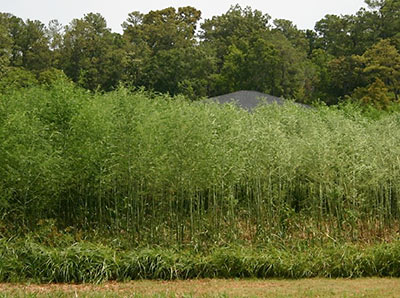
Drought has turned land that used to be part of Lake Houston into a jungle of 14-ft.-tall snake-infested weeds. Waterfront residents of Kings River Village, near the northern end of the lake in Humble, would like to knock down the vegetation that’s sprung up as the lake has receded, and that now surrounds their newly dry backyard docks. But some are proceeding with caution because they don’t own the newfound land and are wary of legal and ecological issues that might result from clear-cutting the newly exposed wetlands. “Right now, we are just in a situation where our kids can’t go back anywhere near the lake because of the weeds and the snakes that are back there,” Clear Sky Dr. resident David Labbe tells the Lake Houston Observer. “We’ve seen an abundance of snakes. We don’t know what rights we have, as homeowners, to go out there and try to remedy the situation.†Labbe has contacted the Army Corps of Engineers, the San Jacinto River Authority, and Houston officials, but hasn’t received an answer yet.
- Lakefront residents seek permission to solve growing drought-induced problem [Lake Houston Observer]
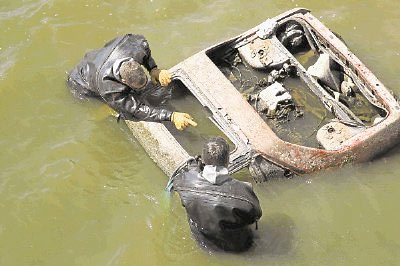
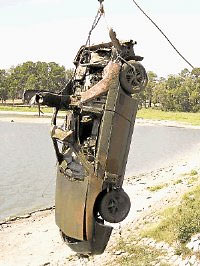 This quarter-century-old Pontiac Fiero was pulled out of Lake Houston yesterday. It’s one of 2 cars recently discovered to have been parked in what used to be the lower depths of the Houston reservoir. One benefit of the drought: Since water levels at the lake have dropped by 6 1/2 to 7 feet, it’s now so much easier to find long-missing vehicles and other debris flavoring the city water supply. The 2-seater was a stolen sportscar believed to have been hanging out in the lake since 1990. Also found sleeping with the fishes near the lake bottom, according to HPD marine unit sergeant T.W. Harding: “tires, logs, all kinds of trash, beer cans beyond belief, a lot of soft drink bottles and beer bottles from the 1950s.â€
This quarter-century-old Pontiac Fiero was pulled out of Lake Houston yesterday. It’s one of 2 cars recently discovered to have been parked in what used to be the lower depths of the Houston reservoir. One benefit of the drought: Since water levels at the lake have dropped by 6 1/2 to 7 feet, it’s now so much easier to find long-missing vehicles and other debris flavoring the city water supply. The 2-seater was a stolen sportscar believed to have been hanging out in the lake since 1990. Also found sleeping with the fishes near the lake bottom, according to HPD marine unit sergeant T.W. Harding: “tires, logs, all kinds of trash, beer cans beyond belief, a lot of soft drink bottles and beer bottles from the 1950s.â€
More pics of the HPD lake patrol unit’s Fiero rescue:
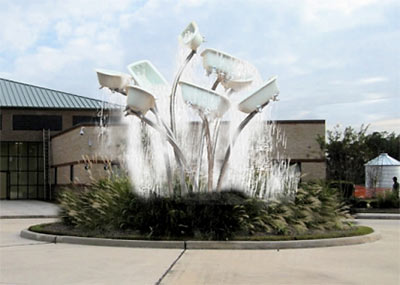
A bouquet of bathtubs by sculptor Donald Lipski will be the centerpiece of a new Houston Water Museum and Education Center in northeast Houston called The WaterWorks. Named “Tubbs” — apparently after Texas country musician and frequent bather Ernest Tubb — Lipski’s sculpture appears to encourage the recycling of water from one bath to the next, although in a playful way perhaps at odds with the standard “short showers only” messages contained in most water-conservation public-information campaigns. The sculpture’s splashing will be controlled, however: That’s a water-recycling system hidden in the bathtub stems.
The museum, scheduled to open in August, will be adjacent to the Northeast Water Purification Plant at the southwest corner of Lake Houston, at 12121 North Sam Houston Parkway East, in Humble.
The bathtub sculpture is a considerable improvement over Lipski’s first proposal for the WaterWorks Museum, the “magic” overflowing water pitcher pictured here:

The Trust for Public Land’s annual report on parks in cities is out and—guess what! Houston miraculously has a whole lot more parkland than it did last year.
In 2006, the Trust’s report showed Houston had 16.5 acres of parkland for every 1,000 residents—below the 20.6-acres-per-1,000 average for cities of similar density.
This year, Houston looks a whole lot better: Suddenly, there’s 27.2 acres of parkland per 1,000 residents. That puts us in third place among cities in the “intermediate-low density” category, and well above the new 17.5 acre average.
How’d it happen? Was it the new 11th Street Park? A secret citywide playground-building program? Not quite. It’s the creative accounting effort launched by Mayor White’s office to make sure the Trust counted every green acre.
White simply wanted Houston judged by the same criteria as other cities, [spokesman Frank] Michel said. “As the mayor likes to say, the facts are our friends.”
Where did the mayor find all that green? Well, here’s his biggest catch:
. . . the city argued successfully that the surface area of Lake Houston — almost 12,000 acres — should be counted as parkland. Harnik said the trust agreed that bodies of water should be counted if they were associated with a park owned by a government agency. Houston acquired the 5,000-acre Lake Houston Park in August 2006 from the state parks department.
Too bad we were limited to just the surface area, though. Next year’s report will probably be even better. Isn’t there a city park somewhere associated with the Ship Channel too?
- Study says Houston ranks among metro leaders in green space [Houston Chronicle]
- City Park Facts [The Trust for Public Land]
- In a Paved Paradise, No Need To Put Up with a Lot of Parks [Swamplot]
- West 11th Street Park: Saved by the Bill [Swamplot]
Lake Houston Photo: Flickr user Demonhawk.


